The British Medieval Biomorphic Sublime
Or, how natural wonders are the archetypes of cultural wonders
Hiya, Readers!
My gosh—has it really been so long since I last wrote? Alas, I’m afraid it has. Late in May, I was offered the opportunity to teach a four-nights-per-week-for-four-weeks summer course, Thinking About Nature (which has influenced this post), at the Kansas City Art Institute. Around teaching and daytime parenting I somehow managed to fit in several guest teaching appearances at our church, Jacob’s Well. And then, at the end of July, I finished off my work there this summer by hosting an indoor mini-golf fundraiser for refugees who are resettling in the Kansas City area. The mini-golf was epic; but in the aftermath, I got sick. So, after a day of sleep, and quarantined to keep my family healthy, I’ve at long last found time to return to Sir Gawain, who’s been sitting at the doorstep of Camelot all summer waiting to depart.
Tallyho!
Aaron
C.S. Lewis’s three-chapter book, The Abolition of Man, is really the reprinting of three talks he delivered as the 1943 Riddell Memorial Lectures at the University of Durham. In the first chapter Lewis refers to what was by then nearly a century-and-a-half-old debate over a literary phenomenon now famously known as “the sublime,” and I want to focus this post on the sublime because I think it’s a good way into Fitt II of Sir Gawain and the Green Knight.
The original debate around the sublime issued from Edmund Burke’s On the Sublime and Beautiful (1757), wherein Burke wrote that
The passion caused by the great and sublime in nature, when those causes operate most powerfully, is astonishment; and astonishment is that state of the soul, in which all its motions are suspended, with some degree of horror. In this case the mind is so entirely filled with its object, that it cannot entertain any other, nor by consequence reason on that object which employs it. Hence arises the great power of the sublime, that far from being produced by them, it anticipates our reasonings, and hurries us on by an irresistible force. Astonishment, as I have said, is the effect of the sublime in its highest degree; the inferior effects are admiration, reverence and respect.1
People, including some of the heavyweights in the history of ideas and literature, have been arguing about this ever since.
Lewis began the Riddell Memorial Lectures with a salvo aimed at an anonymized book he named “the Green Book,” but which we now know is Alec King’s and Martin Ketley’s The Control of Language (1939), because it reduced experiences like the sublime to merely subjective phenomena.2 Lewis quotes King and Ketley thus:
“When the man said This is sublime, he appeared to be making a remark about the waterfall… Actually… he was not making a remark about the waterfall, but a remark about his own feelings. What he was saying was really I have feelings associated in my mind with the word “Sublime”, or shortly, I have sublime feelings.”3
And then he fired back, “If This is sublime is to be reduced at all to a statement about the speaker’s feelings, the proper translation would be I have humble feelings.”4 But he didn’t stop there. King and Ketley’s book was a grade-school grammar text, and Lewis raised the concern that the students who read it
will believe in two propositions: firstly, that all sentences containing a predicate of value are statements about the emotional state of the speaker, and secondly, that all such statements are unimportant… [The authors’] words are that we ‘appear to be saying something very important’ when in reality we are ‘only saying something about our own feelings.’5
Here Lewis is wading into a debate (see what I did there?) that is as old as Burke—so about 200 years old at the point Lewis was writing—by taking the position that, although our feelings may be personal, they are not radically so. Put differently, although we may have private-because-internal experiences, there’s something about certain experiences that we all share. And the sublime, some like Lewis have argued, is one of those private-but-objective, or at least private-but-intersubjective, experiences.
I’ve set up this post on SGGK, fitt II, with a discussion of the sublime because I think that, given my critique of Arthur’s materialism last post, it would be very easy for someone to read SGGK, to see incipient imperialism in Arthur’s bearing and Gawain’s riding out, dismiss the text on those grounds, and not look back. It’s a story born out of an early culture of empire; empire is bad for people, empire is evil; so it’s an evil story. That’s certainly how many of my students have been trained to think. And we need to deal frankly with critiques such as this one. I’ve raised the issue of incipient imperialism because I think there’s a credible argument to be made for that. But if it’s all we see, we miss other important aspects of not only SGGK, but any story from yesteryear that could be described as tinged with the values of empire. So let’s, just for a moment, set aside the martial undertones and the expansionist logic of SGGK as the common sense of the romance, and look instead at the aesthetics.
Scarcely twenty yards from where I’m writing this stands a suit of armor, forged in Italy, in the mid sixteenth century. Maybe it’s more elaborate than Gawain’s armor, especially since SGGK was written in the thirteenth century (metalwork likely advanced some over two centuries), but maybe it isn’t. The Gawain-poet describes the knight’s equipage as “gilded gear,”6 but then goes on for stanzas wondering at its intricacies:
Then sabatons [i.e., armored shoes] first they set on his feet,
his legs lapped in steel in his lordly greaves,
on which the polains they placed, polished and shining
and knit upon his knees with knots all of gold;
then the comely cuisses that cunningly clasped
the thick thews of his thighs they with thongs on him tied;
and next the byrnie, woven of bright steel rings
upon costly quilting, enclosed him about;
and armlets well burnished upon both of his arms,
with gay elbow-pieces and gloves of plate,
and all the goodly gear to guard him whatever betide;
coat-armor richly made,
gold spurs on heel in pride;
girt with a trusty blade,
silk belt around his side.7
Nor is it only Gawain himself, but also Gringolet, his horse, who is so bedecked.
And now Gringolet stood groomed, and girt with a saddle
gleaming right gaily with many gold fringes,
and all newly for the nonce nailed at all points;
adorned with bars was the bridle, with bright gold banded;
the apparelling proud of poitrel and of skirts,
and the crupper and caparison accorded with the saddlebows:
all was arrayed in red with rich gold studded,
so that it glittered and glinted as a gleam of the sun…
…all braided and bound with the brightest gems
upon broad silken broidery, with birds on the seams
like popinjays depainted, here preening and there,
turtles and true-loves, entwined as thickly
as if many sempstresses had the sewing full seven winters in hand.8
You’ll recall how in my last post on SGGK, written in May (way back in hallowed antiquity), I exposited the nef as a type of wonder. I’d like to suggest that, with all the talk of gilding and the descriptions of the intricacies of his armor’s metalwork, Gawain himself is a kind of wonder. And the beginning of fitt II, stanza 26, proves it:
When he was hasped in his armour his harness was splendid:
the least latchet or loop was all lit with gold.
Thus harnessed as he was he hear now his Mass,
that was offered and honoured at the high altar;
and then he came to the king and his court-companions,
and with love he took leave of lords and ladies;
and they kissed him and escorted him, and to Christ him commended.9
In fact, here Gawain is very nef-like, because the ceremony here is very much like the Christening of a ship. In a story from an age before Britain was a maritime power we see the same ritual of sending-forth. This isn’t an American G.I.’s experience at basic training, where he’s broken down, rebuilt, and made a tool of the government. This is a well-loved member of court—Gawain was Arthur’s nephew, according to legend—being sent forth in the very best equipment available, hand-made to fit him and embellished with meaningful symbols.
How do these descriptions compare with the suit here at the Nelson-Atkins Museum of Art, where I regularly come to write? See for yourself.
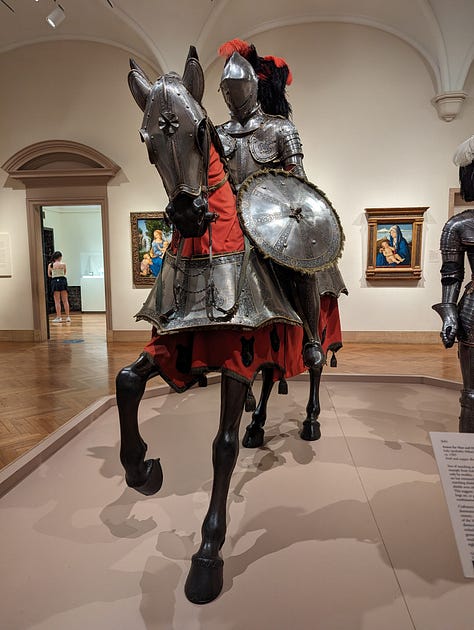
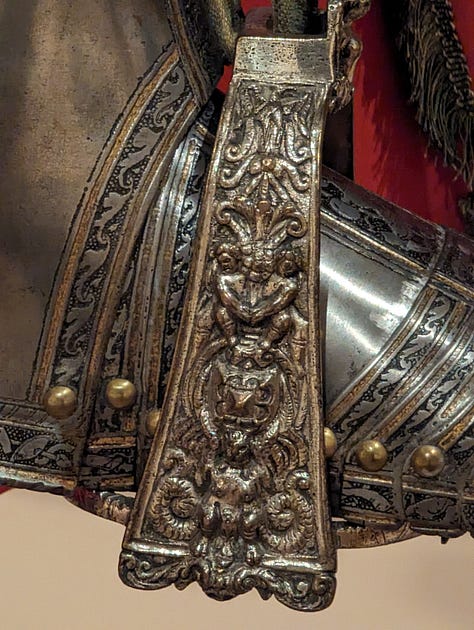
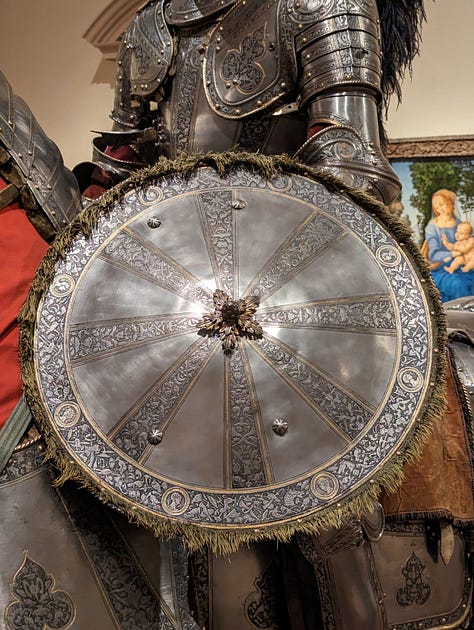
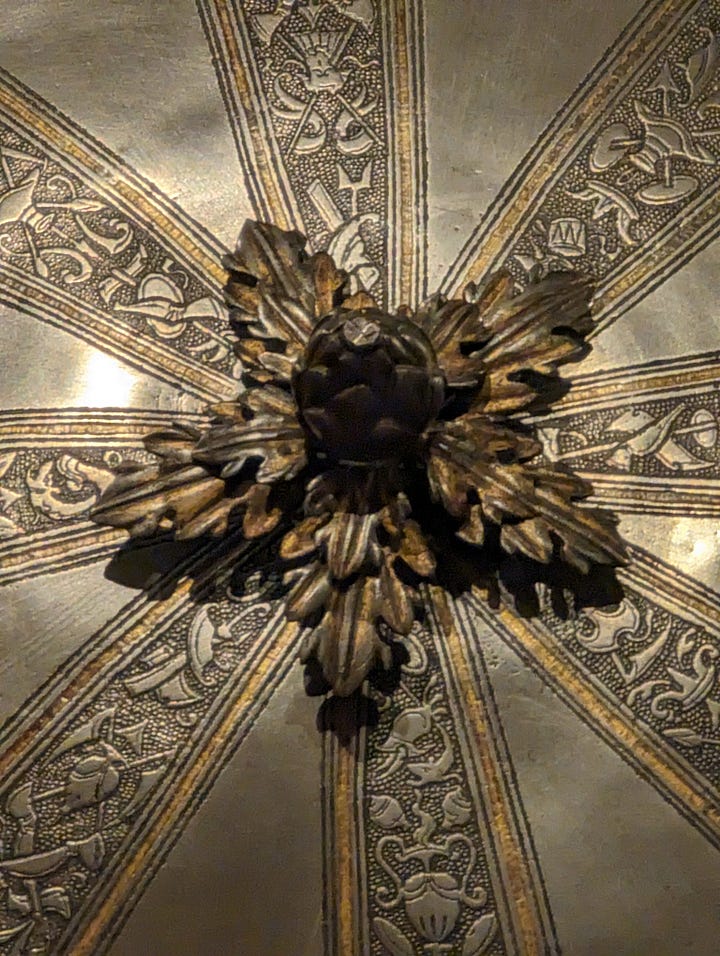
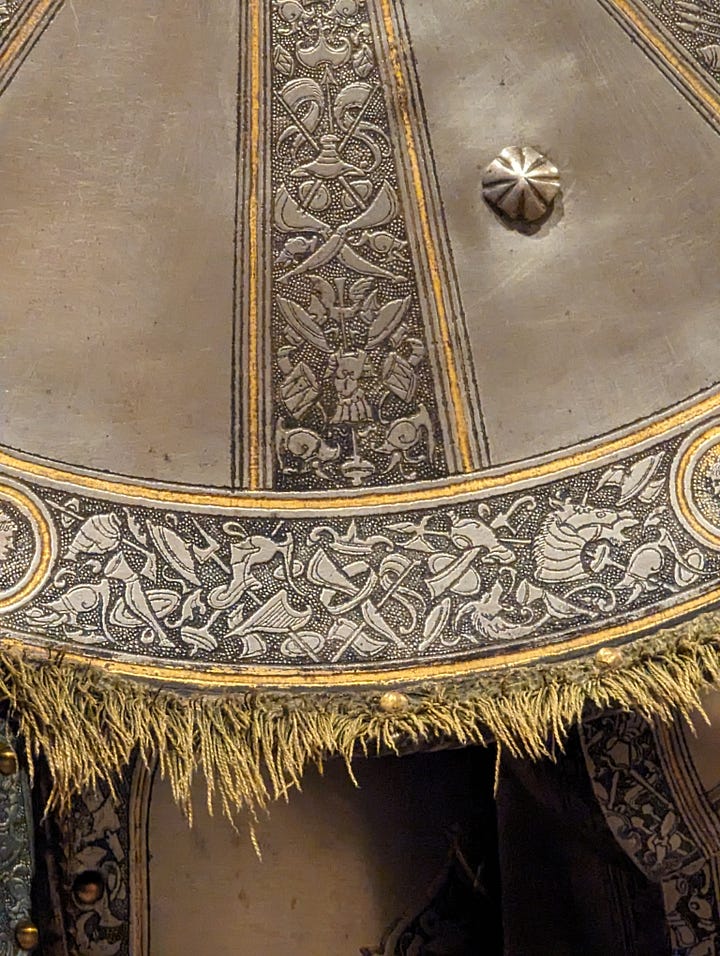
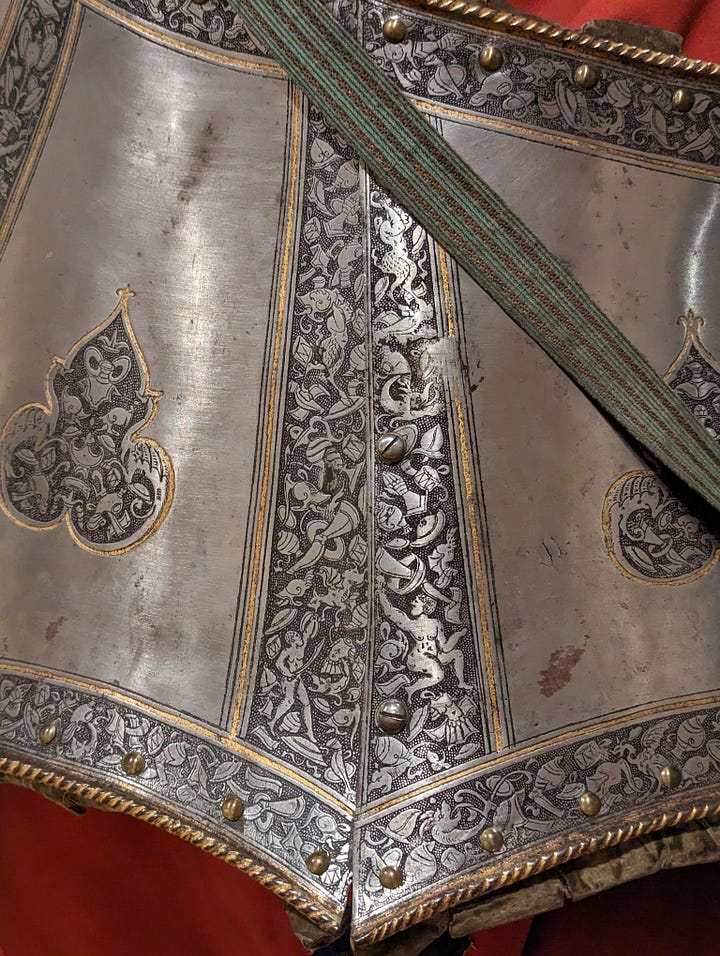
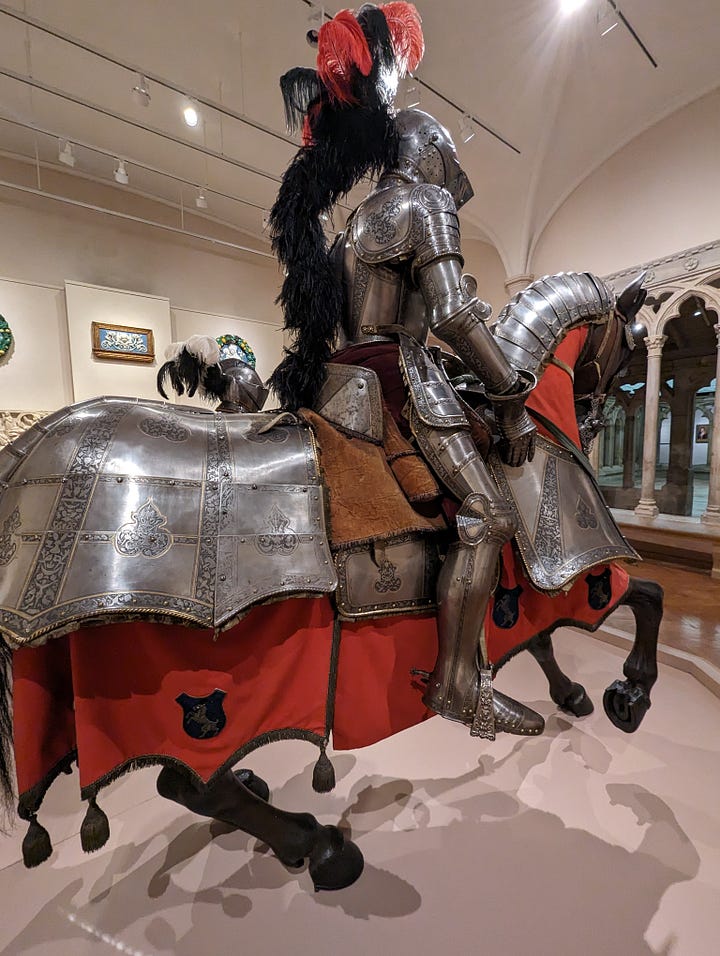
If you’ve been (or if you were) reading SGGK as I was writing this series, first, I apologize for a major delay on this post. But also, you’ll notice on the shield of this suit of armor a pentangle like the one mentioned in the poem, only in this armor the pentangle is made of (oak?) leaves. It makes me wonder whether, in two centuries, SGGK traveled to Italy and was translated well enough that some armorer made a Gawain-inspired suit.
Let’s return to the conversation on the sublime, though. Fitt II of SGGK is rife with the sublime. Look at this scenery!
“All the isles of Anglesey he held on his left…”10
“The knight took pathways strange | by many a lonesome lea, | and oft his view did change | that chapel ere he could see.”11
“Many a cliff he climbed o’er in countries unknown, | far fled from his friends without fellowship he rode.”12 (That line’s for you, LotR fans!)
“So many a marvel in the mountains he met in those lands | that ’twould be tedious the tenth part to tell you thereof.”13
And then comes stanza 32, which has stayed with me since I first read SGGK in the original Middle English:
By a mount in the morning merrily he was riding
into a forest that was deep and fearsomely wild,
with high hills at each hand, and hoar woods beneath
of huge aged oaks by the hundred together;
the hazel and the hawthorn were huddled and tangled
with rough ragged moss around them trailing,
with many birds bleakly on the bare twigs sitting
that piteously piped there for pain of the cold.14
That “huddled and tangled” in Middle English is “harled al samen”—twisted back on itself. If you understand SGGK, especially its sublime landscapes, you have a new perspective on the landscapes, but also the metaphors, in Tolkien’s The Lord of the Rings. This twisted forest is Fangorn’s forbear, and in the twisting itself we get one of the images of evil in Tolkien’s world. Twisted branches—a wreath, something writhen, “twisted.” Like Tolkien’s wraiths, who are wroth, twisted with rage.15 And the Ring itself is “harled al samen,” “twisted back onto itself”: that’s what a ring is, essentially.
One reason I asked for your patience, if you’re prone to see empire here, is that I wanted to draw your attention to the sublimity of the Gawain-poet’s landscapes, for in them—in the birds piping with cold, in the twisted forests with their aged oaks, in their forlorn solitude, but even in their large vistas—we see the pattern for Gawain’s armor—for the popinjays, the Pentangle on his shield (made of oak in the Italian suit here at the Nelson-Atkins Museum), the self-isolation of being engulfed in metal, the grand scale of time and meaning manifest in wrought symbols around the fringe of the plates. I think, often, when we look at power, we miss beauty.
Soon I’ll share a story about acquiring a very special copy of David Nye’s American Technological Sublime (1999), an installment in the ongoing conversation about the sublime that I think is a missing piece of the American psyche with regard to technology and culture. Nye has argued that the American landscape—places like Mt. St. Helens, Yosemite, Yellowstone—inspired the American imagination to such an extent that we designed our social order with that sublimity in mind. The first instance in which Chicago was electrically lit; the lines of our railroads; the sheer scale of the Hoover Dam: all of these partake of what Nye has so aptly dubbed “the American technological sublime.” We see the American technological sublime at air shows, at the Indy 500, at every Superbowl Halftime Show, in major Google and Apple events, and yes, in our films, our car commercials, and those TED Talks I critiqued last January in “How Drones Became Cool.”
Here’s a thought: if the landscapes of America can inspire some phenomenon that Nye calls “the American technological sublime,” then let’s say that Gawain’s wondrous, landscape- and wildlife-inspired armor bespeaks what could be called “the British medieval biomorphic sublime.” What do I mean by that? Only that nature-inspired technology is much older than modern America and probably even older than SGGK. But it’s at least as old as SGGK. I’ll write more later about biomorphism and biomimicry but for now, suffice it to say that humankind has been trying to re-engineer the natural for a long, long time; and part of what’s inspired us to try it is nature’s sublimity. We’re so awed by it, we want to make something that sublime.
Seeing the romance, as a literary genre, as an artifact of empire; or seeing Gawain’s armor as weaponry rather than art; we miss the beauty in humankind’s ambitious imitation of the creation around us. Our souls are larger than their current low estate; and that’s a shame. But Lewis’s reformulation of The Green Book’s language is also worth keeping in mind here. The correlate to an experience of the sublime is humble feelings. I don’t think King and Ketley made a mistake when they said that feeling associated with the sublime are sublime feelings: I think we might say they were admitting, in a way, that they were suffering from that peculiarly modern condition that’s also afflicted Silicon Valley CEOs, a condition wherein the mind becomes infected by a hubris that urges someone to replicate the wonder of creation, and in so doing, to claim power over it—whether or not it’s theirs to claim.
Dr. Aaron M. Long is a Lecturer in English at a flagship state university, and in Philosophy at a historied regional art school. He has published articles in Twentieth-Century Literature, The Nautilus, and Science Fiction Film & Television, among others. You can find him on Twitter (yeah, yeah, on X) or LinkedIn, and his website is here.
Edmund Burke, On the Sublime and Beautiful (New York, NY: John B. Alden, 1885), 50-51. A full-text e-book version of the source is available here.
Alec King and Martin Ketley, The Control of Language: A Critical Approach to Reading and Writing (London, England: Longmans, 1939).
C.S. Lewis, The Abolition of Man (San Francisco, CA: HarperSanFrancisco, 1974), 2.
Lewis, 3.
Lewis, 4-5.
Tolkien and Gordon, II.25. In this and all future citations of SGGK, the Roman numeral designates a fitt of the poem and the Arabic numeral the stanza of that fitt. Hence, in this citation, I am referencing fitt II, stanza 25.
Tolkien and Gordon, II.25.
Tolkien and Gordon, II.26.
Tolkien and Gordon, II.26.
Tolkien and Gordon, II.30.
Tolkien and Gordon, II.30.
Tolkien and Gordon, II.31.
Tolkien and Gordon, II.31.
Tolkien and Gordon, II.32.
Tom Shippey, The Road to Middle Earth (Boston, MA: Houghton Mifflin Co.), 148-150.




What a powerful last sentence! I didn’t think of that angle at all when I read abolition this past week.